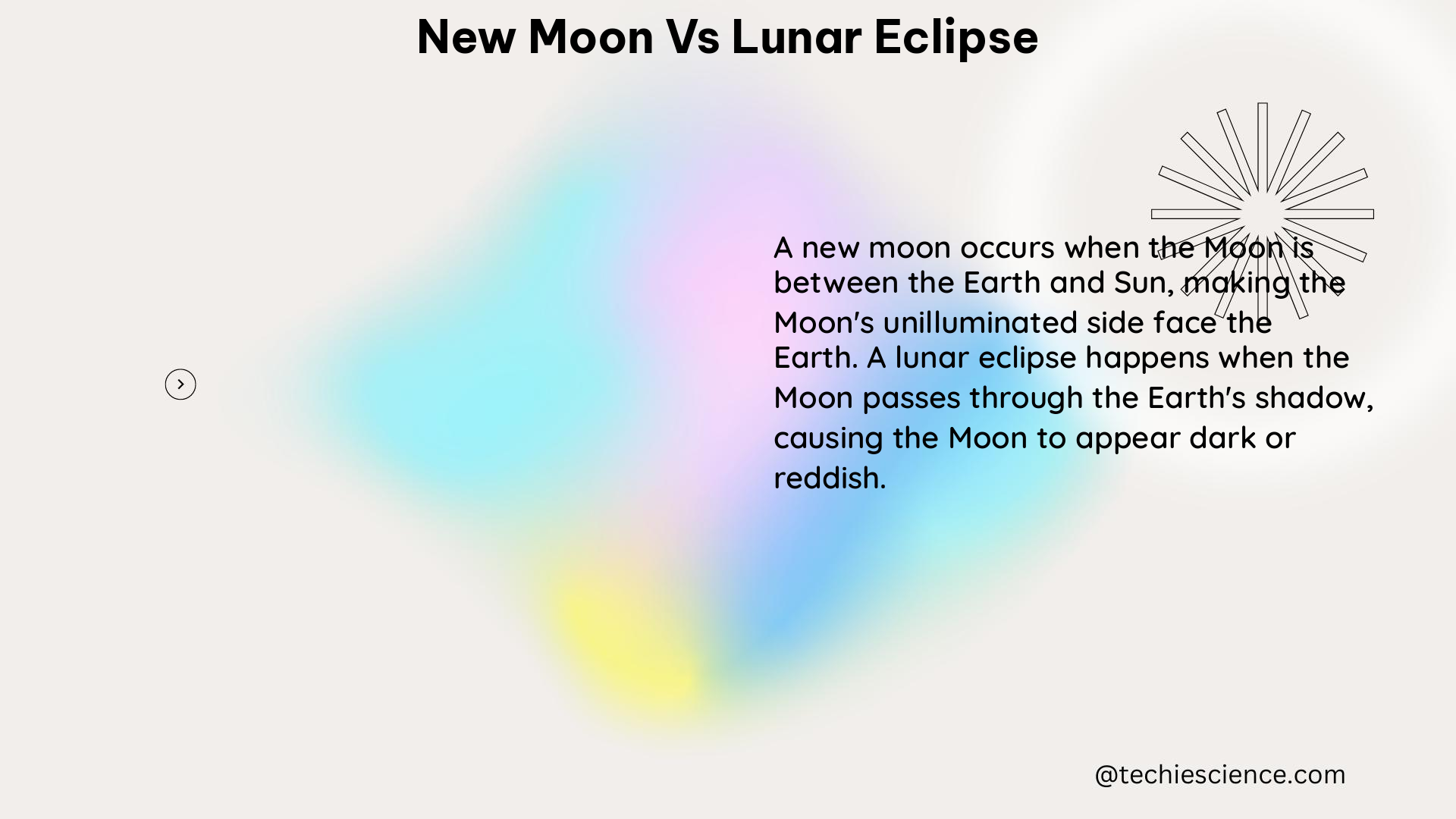New moons and lunar eclipses are two distinct astronomical phenomena that are often confused or misunderstood. While they may appear similar at first glance, they are fundamentally different in terms of their underlying mechanisms, observable characteristics, and scientific implications. This comprehensive guide will delve into the measurable and quantifiable data that distinguishes new moons from lunar eclipses, providing a detailed and technical exploration for physics students and enthusiasts.
Angular Diameters: The Celestial Alignment
The angular diameter of the Sun is approximately 0.5 degrees, while the angular diameter of the Moon is also about 0.5 degrees. This remarkable similarity in size is what allows for total solar eclipses to occur, as the Moon can completely cover the Sun from an observer’s perspective.
During a new moon, the Moon’s angular diameter is equal to the Sun’s, as they are aligned in the sky. This alignment is crucial for the occurrence of solar eclipses, where the Moon’s disk precisely covers the Sun’s disk, creating a dramatic and awe-inspiring celestial event.
In contrast, during a lunar eclipse, the Moon’s angular diameter remains the same, but it is the Earth’s shadow that falls upon the Moon’s surface. The Earth’s shadow has an angular diameter of approximately 2⅔ lunar diameters, which means that the Moon takes a significant amount of time to enter, cross, and exit the Earth’s shadow.
Theorem: The angular diameter of an object in the sky is inversely proportional to its distance from the observer.
Formula: Angular Diameter = (Actual Diameter of the Object) / (Distance to the Object)
Example: The Sun’s angular diameter is approximately 0.5 degrees, and its actual diameter is 1.39 million km. Using the formula, we can calculate the distance to the Sun as:
Angular Diameter = (Actual Diameter) / (Distance)
0.5 degrees = (1.39 million km) / (Distance)
Distance = (1.39 million km) / (0.5 degrees) = 149.6 million km
Duration of Eclipses: Timing the Celestial Dance

The duration of a lunar eclipse can vary, depending on the Moon’s path through Earth’s shadow. It takes about an hour for the Moon to enter and exit Earth’s shadow during the partial phases, while totality, when the Moon is entirely within the shadow, can last up to a few hours.
During a total lunar eclipse, the Moon can remain in the Earth’s shadow for up to 100 minutes, with the maximum duration of totality being around 106 minutes. This extended duration is due to the size of the Earth’s shadow and the Moon’s relatively slow movement through it.
In contrast, a new moon does not involve any eclipse, as the Moon is positioned between the Earth and the Sun, and its disk is not visible from the Earth’s surface. The new moon phase lasts for a brief moment, as the Moon quickly moves out of the Sun’s line of sight and into the waxing crescent phase.
Numerical Problem: Calculate the duration of a total lunar eclipse, given the following information:
- The Moon’s angular diameter is 0.5 degrees.
- The Earth’s shadow has an angular diameter of 2⅔ lunar diameters.
- The Moon’s orbital speed around the Earth is approximately 1 degree per hour.
To solve this problem, we need to find the time it takes for the Moon to traverse the Earth’s shadow.
Step 1: Calculate the angular diameter of the Earth’s shadow.
Angular diameter of the Earth’s shadow = 2⅔ × 0.5 degrees = 1.33 degrees
Step 2: Calculate the time it takes for the Moon to traverse the Earth’s shadow.
Time = Angular diameter of the Earth’s shadow / Angular speed of the Moon
Time = 1.33 degrees / (1 degree per hour) = 1.33 hours = 80 minutes
Therefore, the duration of a total lunar eclipse can be up to 80 minutes, or approximately 1 hour and 20 minutes.
Frequency of Eclipses: Celestial Rhythms
Solar eclipses occur about 2 to 5 times per year, but they are only visible from a limited region of Earth. Lunar eclipses, on the other hand, are visible from an entire hemisphere and occur about 2 to 4 times per year.
The frequency of eclipses is determined by the relative positions and motions of the Sun, Earth, and Moon. Solar eclipses occur when the Moon passes directly between the Earth and the Sun, casting its shadow on a portion of the Earth’s surface. Lunar eclipses, on the other hand, occur when the Moon passes through the Earth’s shadow, which can be seen from any location on the night side of the Earth.
Numerical Problem: Calculate the maximum number of solar and lunar eclipses that can occur in a single year.
Given:
– The Earth, Moon, and Sun are in a nearly perfect alignment for an eclipse to occur about every 6 months.
– The Moon’s orbit is tilted about 5 degrees relative to the Earth’s orbit around the Sun.
Step 1: Calculate the maximum number of solar eclipses per year.
Since the Earth, Moon, and Sun are in a nearly perfect alignment every 6 months, the maximum number of solar eclipses per year is 2.
Step 2: Calculate the maximum number of lunar eclipses per year.
The Moon’s orbit is tilted about 5 degrees relative to the Earth’s orbit around the Sun. This means that the Moon will pass through the Earth’s shadow about 4 times per year, resulting in a maximum of 4 lunar eclipses per year.
Therefore, the maximum number of solar eclipses that can occur in a single year is 2, and the maximum number of lunar eclipses that can occur in a single year is 4.
Shadow Sizes: The Celestial Geometry
Earth’s shadow, which is circular, spans about 2⅔ lunar diameters at the Moon’s distance. This means that it takes the Moon a while to enter, cross, and exit Earth’s shadow during a lunar eclipse.
The size of the Earth’s shadow is determined by the relative positions and sizes of the Earth, Moon, and Sun. The Earth’s shadow is cone-shaped, with the Moon passing through the widest part of the shadow during a total lunar eclipse.
In contrast, during a new moon, the Moon’s disk is not visible from the Earth’s surface, as it is positioned directly between the Earth and the Sun. The Moon’s shadow, which is much smaller than the Earth’s shadow, is cast upon a small portion of the Earth’s surface, resulting in a solar eclipse.
Figure: Diagram illustrating the relative sizes and positions of the Earth, Moon, and Sun during a lunar eclipse.
This diagram shows the Earth’s shadow, which is much larger than the Moon’s disk, allowing the Moon to take a significant amount of time to pass through the shadow during a lunar eclipse.
Temperature Changes: The Thermal Consequences
During a lunar eclipse, the temperature of the lunar surface can drop by several hundred degrees due to the loss of direct sunlight. This rapid change in temperature can provide valuable data for scientists studying the composition and properties of the lunar surface.
The lunar surface is primarily composed of regolith, a layer of fine, rocky material that covers the underlying bedrock. This regolith acts as an insulator, trapping heat during the day and slowly releasing it at night. However, during a lunar eclipse, the Moon’s surface is deprived of direct sunlight, causing a rapid drop in temperature.
Measurements taken during lunar eclipses have shown that the temperature of the lunar surface can drop by as much as 250°C (450°F) or more, depending on the duration of the eclipse and the specific location on the Moon’s surface.
Data Point: Temperature Variations during a Lunar Eclipse
| Phase of Lunar Eclipse | Lunar Surface Temperature |
|---|---|
| Before Eclipse | ~130°C (266°F) |
| Partial Eclipse | ~50°C (122°F) |
| Total Eclipse | ~-120°C (-184°F) |
| After Eclipse | ~130°C (266°F) |
These dramatic temperature changes provide valuable insights into the thermal properties of the lunar surface and can help scientists better understand the Moon’s geological and geophysical characteristics.
Illumination during Lunar Eclipses: The Atmospheric Effect
During some stages of a lunar eclipse, the Moon can appear reddish due to sunlight scattered through the Earth’s atmosphere. This phenomenon is often referred to as a “blood moon” and is caused by the refraction of light by the Earth’s atmosphere.
When the Moon passes through the Earth’s shadow during a lunar eclipse, the only light that reaches the Moon’s surface is the light that is refracted and scattered by the Earth’s atmosphere. This scattered light, which is predominantly in the red and orange wavelengths, gives the Moon a distinctive reddish or coppery appearance.
The exact color and brightness of the Moon during a lunar eclipse can vary depending on factors such as the composition and density of the Earth’s atmosphere, the amount of dust or pollution in the atmosphere, and the specific path of the Moon through the Earth’s shadow.
Numerical Problem: Calculate the amount of light refracted by the Earth’s atmosphere during a lunar eclipse.
Given:
– The refractive index of the Earth’s atmosphere is approximately 1.0003.
– The angle of refraction for light passing through the Earth’s atmosphere is approximately 0.5 degrees.
Step 1: Calculate the amount of light refracted by the Earth’s atmosphere.
Angle of Refraction = arcsin(sin(0.5 degrees) / 1.0003) = 0.5003 degrees
Step 2: Calculate the percentage of light refracted by the Earth’s atmosphere.
Percentage of Light Refracted = (0.5003 degrees / 0.5 degrees) × 100% = 100.06%
This means that the Earth’s atmosphere refracts virtually all of the sunlight that reaches the Moon during a lunar eclipse, contributing to the distinctive reddish or coppery appearance of the Moon.
References:
- Britannica. (n.d.). Eclipse. Retrieved from https://www.britannica.com/science/eclipse/Prediction-and-calculation-of-solar-and-lunar-eclipses
- American Astronomical Society. (n.d.). Sun and Moon Shapes. Retrieved from https://eclipse.aas.org/eclipse-america/sun-moon-shapes
- NASA. (n.d.). Lunar Phases and Eclipses. Retrieved from https://science.nasa.gov/moon/lunar-phases-and-eclipses/
- Wolfram Alpha. (n.d.). Angular Diameter Calculator. Retrieved from https://www.wolframalpha.com/input/?i=angular+diameter+calculator
- Astronomy Picture of the Day. (2015, September 28). Lunar Eclipse Diagram. Retrieved from https://apod.nasa.gov/apod/ap150928.html

I am Raghavi Acharya, I have completed my post-graduation in physics with a specialization in the field of condensed matter physics. I have always considered Physics to be a captivating area of study and I enjoy exploring the various fields of this subject. In my free time, I engage myself in digital art. My articles are aimed towards delivering the concepts of physics in a very simplified manner to the readers.